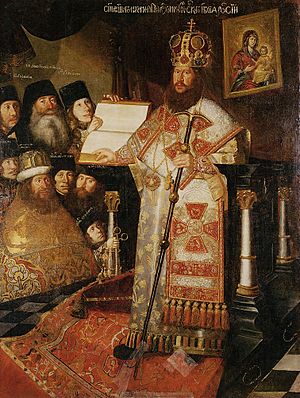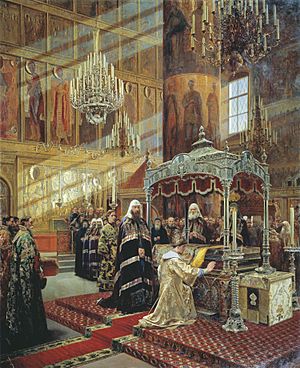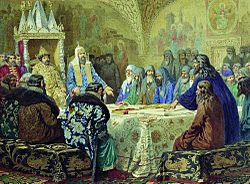Patriarch Nikon of Moscow facts for kids
Quick facts for kids Nikon |
|
|---|---|
| Patriarch of Moscow and all Rus' | |
 |
|
| Church | Russian Orthodox Church |
| See | Moscow |
| Enthroned | 1652 |
| Reign ended | 1666 |
| Predecessor | Patriarch Joseph of Moscow |
| Successor | Patriarch Joasaphus II of Moscow |
| Personal details | |
| Birth name | Никита Минин |
| Born | 7 May 1605 Veldemanovo near Nizhny Novgorod, Tsardom of Russia |
| Died | 17 August 1681 (aged 76) Church of St. Nicholas in Tropino, Yaroslavl, Tsardom of Russia |
| Buried | New Jerusalem Monastery |
Nikon (Russian: Ни́кон, Old Russian: Нїконъ), born Nikita Minin (Никита Минин; 7 May 1605 – 17 August 1681), was a very important leader of the Russian Orthodox Church. He served as the seventh Patriarch of Moscow and all Rus' from 1652 to 1666.
Nikon was known for being a great speaker and very religious. He had a close friendship with Tsar Alexis of Russia. Nikon brought many changes to the church, especially in its religious services. These changes were not popular with everyone, especially those who liked the old ways. This disagreement eventually led to a big split in the Russian Orthodox Church, called the Raskol (schism). For many years, Nikon was a powerful figure, sometimes even more powerful than the Tsar himself. In 1667, he was put on trial by church leaders. He lost his position and became a simple monk.
Contents
Nikon's Early Life and Calling
Nikon was born on May 7, 1605, in a small village near Nizhny Novgorod. His father was a Russian peasant farmer. Sadly, his mother died soon after he was born, and his stepmother treated him badly. He learned to read and write from a local priest.
When he was 12, he ran away from home. He went to the Makaryev Monastery and stayed there until he was 19, learning about church life. Later, he returned home, got married, and became a village priest.
Some merchants from Moscow noticed how well he spoke. They helped him become a priest in a busy church in the capital city. He served there for about ten years. During this time, his three young children died. Nikon saw this as a sign from God. He decided to become a monk. First, he convinced his wife to become a nun. Then, he went to a quiet place on the Solovetsky Islands in the White Sea. When he became a monk, he took the name Nikon.
In 1639, he had a disagreement with the monastery's leader. He left by boat, and a storm pushed his boat to Kiy Island. Later, he would build a large monastery there. He eventually reached another monastery, the Kozheozersky Monastery, and became its abbot (leader) in 1643.
Meeting the Tsar
In 1646, Nikon visited Moscow as part of his duties. He met the young Tsar Alexei I, as was the custom. Tsar Alexei was a very religious person. He was very impressed with Nikon. Because of this, the Tsar made Nikon the head of the important Novospassky Monastery in Moscow. This monastery was special because it was connected to the Tsar's family, the House of Romanovs.
The Zealots of Piety
While at the Novospassky Monastery, Nikon joined a group called the Zealots of Piety. This group started in the late 1630s. It included church leaders and regular people who gathered around Stefan Vonifatiyev, the Tsar's confessor.
After a difficult time in Russia called the Time of Troubles, this group believed that God was angry because people were not religious enough. They wanted to bring back strong Russian Orthodox faith. They also wanted people to become more religious. Important members included Fyodor Rtishchev and Ivan Neronov.
In 1649, Nikon became the metropolitan of Great Novgorod. He had special powers there. During his time, a riot broke out in the city. Nikon was even beaten by the angry crowd. But he managed to calm things down peacefully by leading a religious procession.
Becoming Patriarch (1652)
On August 1, 1652, Nikon was chosen to be the patriarch of Moscow. Nikon knew that many noble families did not like him. So, he refused the offer several times.
It was very difficult to convince Nikon to become the head of the Russian Church. He finally agreed only after the Tsar himself and the noble boyars knelt down and begged him. He accepted, but only after everyone promised to obey him in all matters concerning the church's beliefs, rules, and practices.
Nikon's Church Reforms
When Nikon became Patriarch, there was already talk of changing the church. Some church leaders had started to update the church service books. But they were too afraid to make big changes.
Nikon, however, started bold reforms. He asked learned Greek church leaders from other countries for advice. He invited them to Moscow. Scholars from Constantinople and Kiev told Nikon that the Russian service books were different from the Greek ones. They also said that the icons used in Russia looked too much like Western European art, not the older, traditional Greek styles.
Nikon strongly criticized the use of these newer icons. He ordered his soldiers to search houses for them. His men would scratch out the eyes of these "wrong" icons and parade them through the town to make fun of them. He also made a rule saying that anyone who made or used such icons in the future would be severely punished.
Later studies showed that the Russian service books were actually older than the Greek ones used at the time. The Greek books had been changed several times over the years.
In 1654, Nikon called a meeting of church leaders (a synod) to look at the service books again. Most of the leaders decided that they should follow the Greek traditions rather than their own older ones. Another council in Moscow in 1656 approved these changes. It also condemned those who disagreed, including some of the original church leaders. These reforms happened at the same time as a big plague in 1654.
Nikon also strictly banned the building of tent-like churches (like Saint Basil's Cathedral). Many old churches that did not follow the new rules were torn down. New churches were built in the "Old Byzantine" style. This strictness made many people, who became known as the Old Believers, hate Nikon and his changes.
Nikon's Building Projects
Nikon built many beautiful and large monasteries. He filled them with valuable libraries. He sent people all over Russia and the East to find precious Greek and Slavonic manuscripts, both religious and non-religious.
Some of the important monasteries he founded include the Valday Iversky Monastery, the New Jerusalem Monastery, and the Kiy Island Monastery.
Nikon's Political Power

From 1652 to 1658, Nikon was almost like a partner to the Tsar, not just a minister. He was allowed to use the Tsar's special title in official papers and letters. This was especially true during the wars with the Polish-Lithuanian Commonwealth from 1654 to 1667. When the Tsar was away with his armies, he left Nikon in charge of Moscow. This made some of the high-ranking boyars (nobles) very unhappy.
Nikon wanted the Church to be separate from the government. He believed that the Church and the state should work together but remain independent. He said that "There are two swords of authority, that is, the spiritual and the secular." He also believed that the "supreme Bishop is higher than the Tsar" in church matters. He wanted the Church to have a clear structure, with the Patriarch fully in control. Nikon and Tsar Alexei were very close. The Tsar even made Nikon the godfather of all his children.
Nikon especially disagreed with the Sobornoye Ulozheniye (Russian Legal Code) of 1649. This law lowered the status of church leaders and made the Church dependent on the state. It also said that taxes from monastery lands should go to the state.
However, Nikon's actions created many enemies. By the summer of 1658, they convinced Tsar Alexei that Nikon was becoming too powerful and overshadowing him. Tsar Alexei suddenly became distant from his "bosom friend."
Nikon Leaves Moscow (1658)
As a test of power, and perhaps hoping to show how important he was, Nikon publicly took off his patriarchal robes in 1658. He went to live at the New Jerusalem Monastery, which he had founded near Moscow. But he did not officially resign from his position.
For almost two years, Tsar Alexei and Nikon remained apart, and their conflict was not solved. In February 1660, a meeting of church leaders was held in Moscow to choose a new Patriarch. The position had been empty for nearly two years. The meeting decided that a new patriarch should be chosen. They also said that Nikon had lost his rank as a bishop and even his priestly orders.
However, a great church expert named Epifany Slavinetsky strongly disagreed with the second part of this decision. In the end, the whole discussion fell apart. The Tsar was not sure if the meeting's decisions were truly valid, so he did not enforce them.
For six more years, the Russian Orthodox Church remained without a patriarch. The question of what to do about Nikon became more and more complicated. Almost every expert from the Eastern Orthodox Church was asked for their opinion, but no two agreed. Finally, the matter was sent to a large meeting of Orthodox church leaders from all over.
Condemned by the Synod (1667)
In December 1667, Nikon was put on trial by a large meeting of church officials, known as the Great Moscow Synod. It was led by two foreign Patriarchs and included many bishops and archbishops.
During the trial, Nikon strongly argued that the church's authority should be supreme, but only in church matters.
On December 12, 1667, the synod declared Nikon guilty. They said he had insulted the Tsar and the whole Russian Church. They also said he had wrongly removed Paul, the bishop of Kolomna, and had beaten his servants. His punishment was to lose all his church positions. From then on, he was to be known simply as the monk Nikon. On the same day, he was sent as a prisoner to the far northern Ferapontov monastery. However, the very same council that removed Nikon also confirmed all his church reforms. They condemned anyone who refused to accept them, like the protopope Avvakum.
Nikon lived longer than Tsar Alexis. He had become somewhat friendly with the Tsar again in 1671. In 1681, the new Tsar Fedor (Alexis's son) heard that Nikon was dying. He allowed Nikon to return to Moscow and live in his old home, the New Jerusalem Monastery. Nikon died in Tropino, near Yaroslavl, on August 17, 1681, while on his way there. The monastery was not finished, but the royal family made sure it was completed. Nikon's cleric later wrote that for the church's opening in 1685, Tserevna Tatyana prepared gold and silver, arranged for icons, and personally embroidered special cloths for the church.
Images for kids
See also
 In Spanish: Nikon de Moscú para niños
In Spanish: Nikon de Moscú para niños



